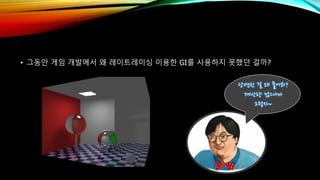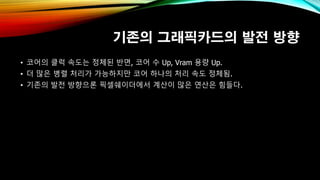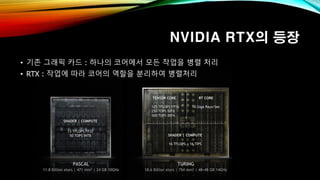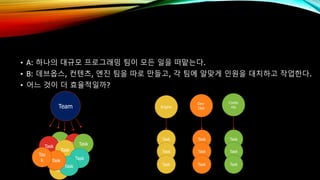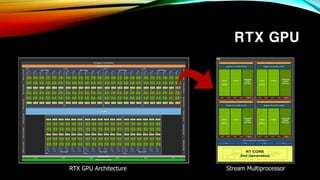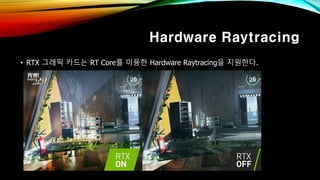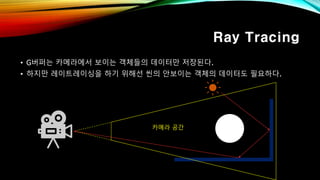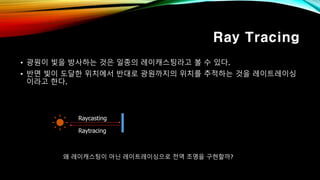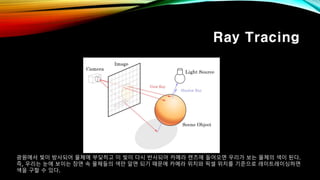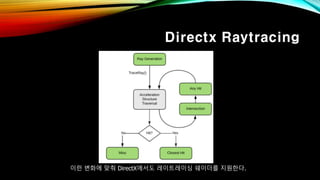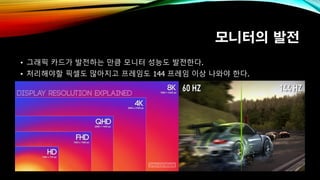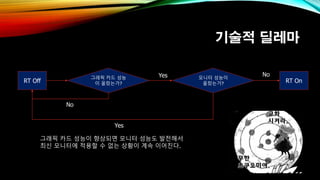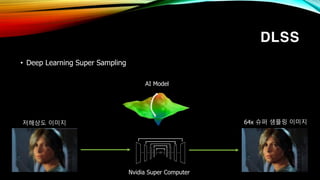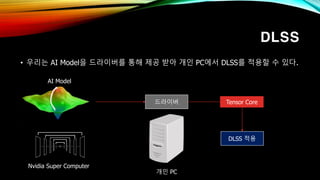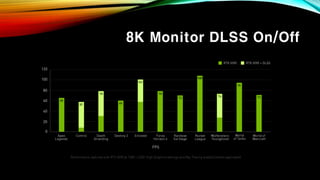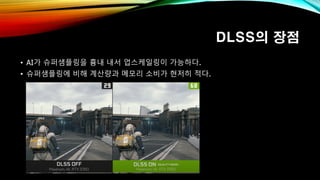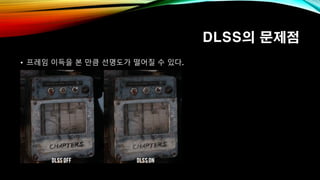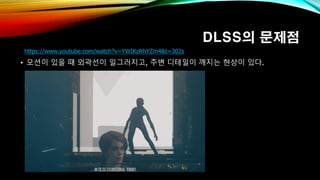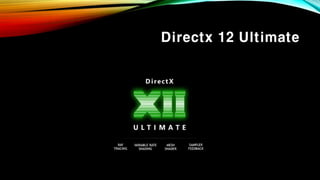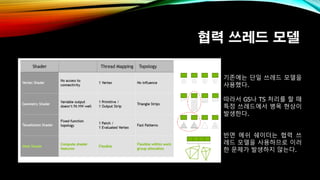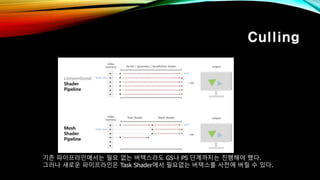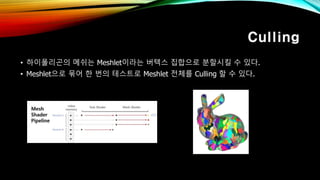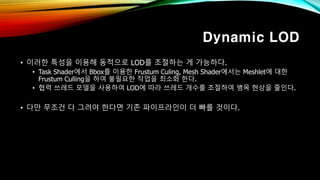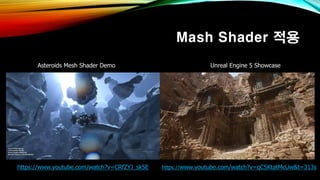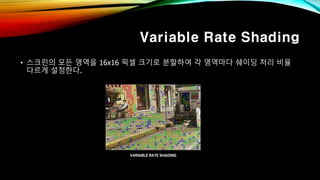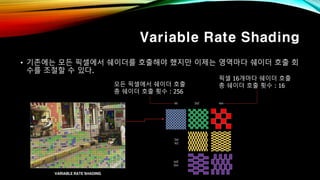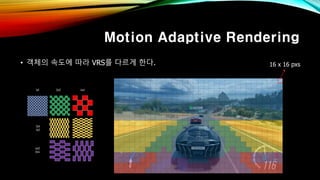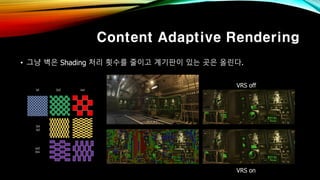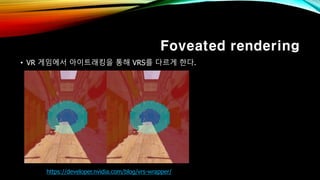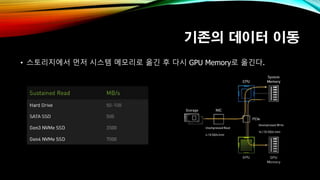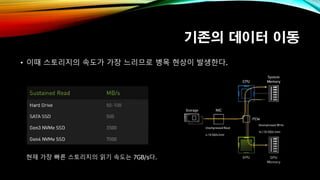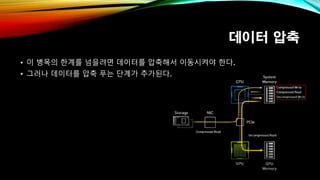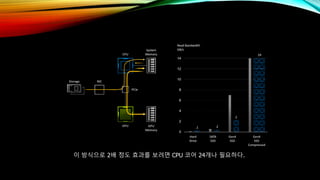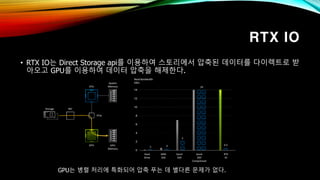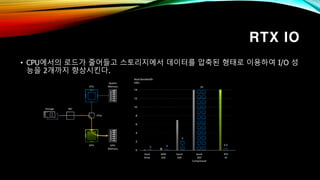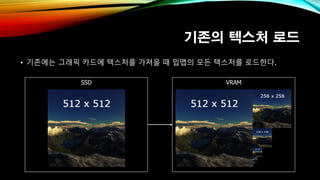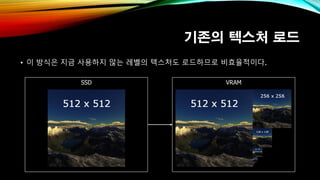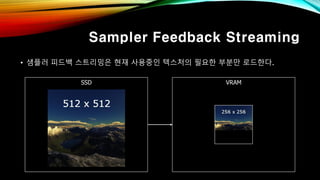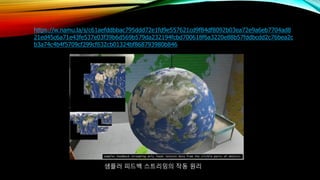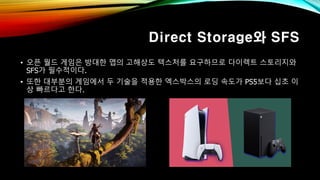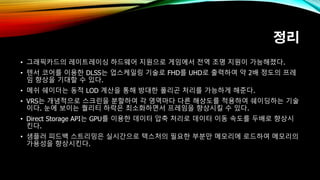진нҷ”н•ҳлҠ” м»ҙн“Ён„° н•ҳл“ңмӣЁм–ҙмҷҖ кІҢмһ„ к°ңл°ң кё°мҲ мқҳ л°ңм „
- 1. 진нҷ”н•ҳлҠ” м»ҙн“Ён„° н•ҳл“ңмӣЁм–ҙмҷҖ кІҢмһ„ к°ңл°ң кё°мҲ мқҳ л°ңм „ 2020-11-07 м ң 552нҡҢ лҚ°лёҢлЈЁнӮӨ мҠӨн„°л”” л°ңн‘ңмһҗ : мқҙм„қмҡ°
- 2. вҖў к·ёлҸҷм•Ҳ кІҢмһ„ к°ңл°ңм—җм„ң мҷң л ҲмқҙнҠёл ҲмқҙмӢұ мқҙмҡ©н•ң GIлҘј мӮ¬мҡ©н•ҳм§Җ лӘ»н–ҲлҚҳ кұёк№Ң? лӢ№м—°н•ң кұё мҷң л¬јм–ҙлҙҗ? кі„мӮ°лҹү л§ҺмңјлӢҲк№Ң к·ёл Үм§Җ~
- 3. кё°мЎҙмқҳ к·ёлһҳн”Ҫм№ҙл“ңмқҳ л°ңм „ л°©н–Ҙ вҖў мҪ”м–ҙмқҳ нҒҙлҹӯ мҶҚлҸ„лҠ” м •мІҙлҗң л°ҳл©ҙ, мҪ”м–ҙ мҲҳ Up, Vram мҡ©лҹү Up. вҖў лҚ” л§ҺмқҖ лі‘л ¬ мІҳлҰ¬к°Җ к°ҖлҠҘн•ҳм§Җл§Ң мҪ”м–ҙ н•ҳлӮҳмқҳ мІҳлҰ¬ мҶҚлҸ„ м •мІҙлҗЁ. вҖў кё°мЎҙмқҳ л°ңм „ л°©н–ҘмңјлЎ н”Ҫм…ҖмүҗмқҙлҚ”м—җм„ң кі„мӮ°мқҙ л§ҺмқҖ м—°мӮ°мқҖ нһҳл“ӨлӢӨ.
- 4. NVIDIA RTXмқҳ л“ұмһҘ вҖў кё°мЎҙ к·ёлһҳн”Ҫ м№ҙл“ң : н•ҳлӮҳмқҳ мҪ”м–ҙм—җм„ң лӘЁл“ мһ‘м—…мқ„ лі‘л ¬ мІҳлҰ¬ вҖў RTX : мһ‘м—…м—җ л”°лқј мҪ”м–ҙмқҳ м—ӯн• мқ„ 분лҰ¬н•ҳм—¬ лі‘л ¬мІҳлҰ¬
- 5. Task Task Task вҖў A: н•ҳлӮҳмқҳ лҢҖк·ңлӘЁ н”„лЎңк·ёлһҳл°Қ нҢҖмқҙ лӘЁл“ мқјмқ„ л– л§ЎлҠ”лӢӨ. вҖў B: лҚ°лёҢмҳөмҠӨ, м»Ён…җмё , 엔진 нҢҖмқ„ л”°лЎң л§Ңл“Өкі , к°Ғ нҢҖм—җ м•Ңл§һкІҢ мқёмӣҗмқ„ лҢҖм№ҳн•ҳкі мһ‘м—…н•ңлӢӨ. вҖў м–ҙлҠҗ кІғмқҙ лҚ” нҡЁмңЁм Ғмқјк№Ң? Team Task Task Task Task Task Engine Dev- Ops Conte nts Task Task Task Task Task Task Task Task TaskTask Task Tas k
- 6. RTX GPU RTX GPU Architecture Stream Multiprocessor
- 7. RTX GPU SM Pascal SM Ampere SM
- 8. Hardware Raytracing вҖў RTX к·ёлһҳн”Ҫ м№ҙл“ңлҠ” RT CoreлҘј мқҙмҡ©н•ң Hardware Raytracingмқ„ м§Җмӣҗн•ңлӢӨ.
- 9. Typical Scene Rendering Render G-Buffer Objects мЎ°лӘ… кі„мӮ° Scene Color Buffer Depth Buffer G-Buffer Normal Map Specular property
- 10. к·ёл ҮкІҢ н•ҳл©ҙ м•ҲлҸјмҡ”! мһҗ! м—¬кё°м„ң нҖҙмҰҲ! л©ҳл§Ҳм§ұмқҖ мҷң м•ҲлҗңлӢӨкі н–Ҳмқ„к№Ңмҡ”? мқҢ . . . л ҲмқҙнҠёл ҲмқҙмӢұлҸ„ G-лІ„нҚј мқҙмҡ©н•ҙм„ң мЎ°лӘ… кі„мӮ°н•ҳл©ҙ лҗҳкІ м§Җ?
- 11. Ray Tracing вҖў GлІ„нҚјлҠ” м№ҙл©”лқјм—җм„ң ліҙмқҙлҠ” к°қмІҙл“Өмқҳ лҚ°мқҙн„°л§Ң м ҖмһҘлҗңлӢӨ. вҖў н•ҳм§Җл§Ң л ҲмқҙнҠёл ҲмқҙмӢұмқ„ н•ҳкё° мң„н•ҙм„ м”¬мқҳ м•ҲліҙмқҙлҠ” к°қмІҙмқҳ лҚ°мқҙн„°лҸ„ н•„мҡ”н•ҳлӢӨ. м№ҙл©”лқј кіөк°„
- 12. Ray Tracing вҖў кҙ‘мӣҗмқҙ л№ӣмқ„ л°©мӮ¬н•ҳлҠ” кІғмқҖ мқјмў…мқҳ л ҲмқҙмәҗмҠӨнҢ…лқјкі ліј мҲҳ мһҲлӢӨ. вҖў л°ҳл©ҙ л№ӣмқҙ лҸ„лӢ¬н•ң мң„м№ҳм—җм„ң л°ҳлҢҖлЎң кҙ‘мӣҗк№Ңм§Җмқҳ мң„м№ҳлҘј 추м Ғн•ҳлҠ” кІғмқ„ л ҲмқҙнҠёл ҲмқҙмӢұ мқҙлқјкі н•ңлӢӨ. Raycasting Raytracing мҷң л ҲмқҙмәҗмҠӨнҢ…мқҙ м•„лӢҢ л ҲмқҙнҠёл ҲмқҙмӢұмңјлЎң м „м—ӯ мЎ°лӘ…мқ„ кө¬нҳ„н• к№Ң?
- 13. Ray Tracing кҙ‘мӣҗм—җм„ң л№ӣмқҙ л°©мӮ¬лҗҳм–ҙ л¬јмІҙм—җ л¶Җл”ӘнһҲкі мқҙ л№ӣмқҙ лӢӨмӢң л°ҳмӮ¬лҗҳм–ҙ м№ҙл©”лқј л ҢмҰҲм—җ л“Өм–ҙмҳӨл©ҙ мҡ°лҰ¬к°Җ ліҙлҠ” л¬јмІҙмқҳ мғүмқҙ лҗңлӢӨ. мҰү, мҡ°лҰ¬лҠ” лҲҲм—җ ліҙмқҙлҠ” мһҘл©ҙ мҶҚ л¬јмІҙл“Өмқҳ мғүл§Ң м•Ңл©ҙ лҗҳкё° л•Ңл¬ём—җ м№ҙл©”лқј мң„м№ҳмҷҖ н”Ҫм…Җ мң„м№ҳлҘј кё°мӨҖмңјлЎң л ҲмқҙнҠёл ҲмқҙмӢұн•ҳл©ҙ мғүмқ„ кө¬н• мҲҳ мһҲлӢӨ.
- 14. Ray Tracing вҖў кҙ‘мӣҗм—җ лҸ„лӢ¬н•ҳкё° н• л•Ңк№Ңм§Җ л ҲмқҙнҠёл ҲмқҙмӢұмқҖ мһ¬к·Җм ҒмңјлЎң лҸҷмһ‘н•ңлӢӨ. 1 2 3
- 15. н•ңл§Ҳл””лЎң GPUм—җм„ң л¬јлҰ¬ м—°мӮ°мқ„ н•ҙм•ј лҗңлӢӨлҠ” кІғвҖҰ.
- 16. Bounding Volume Hierarchy вҖў лӢӨн–үмқё кІғмқҖ RT Coreм—җм„ң BVHлҘј м§Җмӣҗн•ҳм—¬ кі„мӮ°мқ„ мөңмҶҢн•ң н•ңлӢӨ.
- 17. Directx Raytracing мқҙлҹ° ліҖнҷ”м—җ л§һм¶° DirectXм—җм„ңлҸ„ л ҲмқҙнҠёл ҲмқҙмӢұ мүҗмқҙлҚ”лҘј м§Җмӣҗн•ңлӢӨ.
- 18. Ray Tracing On/Off м•„л¬ҙлҰ¬ н•ҳл“ңмӣЁм–ҙ RTлҘј м“ҙлӢӨ н•ҙлҸ„ кі„мӮ°мқҙ л§Һм•„ лҠҗлҰ° кұҙ ліҖн•Ём—ҶлӢӨ. Ray Traced Shadow On / Off
- 19. лӘЁлӢҲн„°мқҳ л°ңм „ вҖў к·ёлһҳн”Ҫ м№ҙл“ңк°Җ л°ңм „н•ҳлҠ” л§ҢнҒј лӘЁлӢҲн„° м„ұлҠҘлҸ„ л°ңм „н•ңлӢӨ. вҖў мІҳлҰ¬н•ҙм•јн• н”Ҫм…ҖлҸ„ л§Һм•„м§Җкі н”„л Ҳмһ„лҸ„ 144 н”„л Ҳмһ„ мқҙмғҒ лӮҳмҷҖм•ј н•ңлӢӨ.
- 20. кё°мҲ м Ғ л”ңл Ҳл§Ҳ к·ёлһҳн”Ҫ м№ҙл“ң м„ұлҠҘ мқҙ мҳ¬лһҗлҠ”к°Җ?RT Off лӘЁлӢҲн„° м„ұлҠҘмқҙ мҳ¬лһҗлҠ”к°Җ? Yes No Yes RT On No к·ёлһҳн”Ҫ м№ҙл“ң м„ұлҠҘмқҙ н–ҘмғҒлҗҳл©ҙ лӘЁлӢҲн„° м„ұлҠҘлҸ„ л°ңм „н•ҙм„ң мөңмӢ лӘЁлӢҲн„°м—җ м Ғмҡ©н• мҲҳ м—ҶлҠ” мғҒнҷ©мқҙ кі„мҶҚ мқҙм–ҙ진лӢӨ.
- 21. мқҙ л¬ём ңлҘј н•ҙкІ°н•ҳкё° мң„н•ҙ лӮҙк°Җ мҷ”лӢӨ
- 22. DLSS вҖў м Җн•ҙмғҒлҸ„ мқҙлҜём§ҖлЎң кі н•ҙмғҒлҸ„ мқҙлҜём§ҖлҘј м¶ңл Ҙн•ҳлҠ” мқҙлҜём§Җ м—…мҠӨмјҖмқјл§Ғ кё°мҲ мқҳ мқјмў…мқҙлӢӨ. DLSS FHD UHD
- 23. DLSS вҖў Deep Learning Super Sampling Nvidia Super Computer AI Model 64x мҠҲнҚј мғҳн”Ңл§Ғ мқҙлҜём§Җм Җн•ҙмғҒлҸ„ мқҙлҜём§Җ
- 24. DLSS вҖў мҡ°м„ 엔비디아 мҠҲнҚјм»ҙн“Ён„°мқҳ AIм—җкІҢ м Җн•ҙмғҒлҸ„ мқҙлҜём§ҖмҷҖ кі н•ҙмғҒлҸ„ мқҙлҜём§ҖлҘј мӨҖлӢӨ. Nvidia Super Computer AI Model
- 25. DLSS вҖў к·ё лӢӨмқҢ AIм—җкІҢ м Җн•ҙмғҒлҸ„ мқҙлҜём§ҖлҘј кі н•ҙмғҒлҸ„ мқҙлҜём§ҖлЎң л§Ңл“ңлҠ” нӣҲл Ёмқ„ мӢңнӮЁлӢӨ. AI Model
- 26. DLSS вҖў мқҙлҘј нҶөн•ҙ м Җн•ҙмғҒлҸ„ мқҙлҜём§ҖлҘј кі н•ҙмғҒлҸ„ мқҙлҜём§ҖлЎң м—…мҠӨмјҖмқјл§Ғ н•ҳлҠ” AI лӘЁлҚёмқ„ л§Ңл“ лӢӨ. AI Model
- 27. DLSS вҖў мҡ°лҰ¬лҠ” AI Modelмқ„ л“ңлқјмқҙлІ„лҘј нҶөн•ҙ м ңкіө л°ӣм•„ к°ңмқё PCм—җм„ң DLSSлҘј м Ғмҡ©н• мҲҳ мһҲлӢӨ. л“ңлқјмқҙлІ„ Nvidia Super Computer AI Model к°ңмқё PC DLSS м Ғмҡ© Tensor Core
- 28. DLSS вҖў DLSSлҘј м Ғмҡ©н•ҳл©ҙ м•Ҫ 1.5 ~ 2л°° м •лҸ„мқҳ н”„л Ҳмһ„ н–ҘмғҒмқ„ ліј мҲҳ мһҲлӢӨкі н•ңлӢӨ. м•„н•ҳ! к·ёлҹ¬л©ҙ FHDм—җм„ң RTлҘј м Ғмҡ©н•ҳкі DLSSлЎң м—…мҠӨмјҖмқјл§Ғ н•ҳл©ҙ UHDм—җм„ң л ҲмқҙнҠёл ҲмқҙмӢұн•ң нҡЁкіјлҘј ліј мҲҳ мһҲлҠ” кұ°кө¬лӮҳ! FHD RT м Ғмҡ© FHD DLSS м Ғмҡ©
- 29. 8K Monitor DLSS On/Off
- 30. DLSSмқҳ мһҘм җ вҖў AIк°Җ мҠҲнҚјмғҳн”Ңл§Ғмқ„ нқүлӮҙ лӮҙм„ң м—…мҠӨмјҖмқјл§Ғмқҙ к°ҖлҠҘн•ҳлӢӨ. вҖў мҠҲнҚјмғҳн”Ңл§Ғм—җ 비н•ҙ кі„мӮ°лҹүкіј л©”лӘЁлҰ¬ мҶҢ비к°Җ нҳ„м ҖнһҲ м ҒлӢӨ.
- 31. DLSSмқҳ л¬ём ңм җ вҖў н”„л Ҳмһ„ мқҙл“қмқ„ ліё л§ҢнҒј м„ лӘ…лҸ„к°Җ л–Ём–ҙм§Ҳ мҲҳ мһҲлӢӨ.
- 32. DLSSмқҳ л¬ём ңм җ вҖў лӘЁм…ҳмқҙ мһҲмқ„ л•Ң мҷёкіҪм„ мқҙ мқјк·ёлҹ¬м§Җкі , мЈјліҖ л””н…Ңмқјмқҙ к№Ём§ҖлҠ” нҳ„мғҒмқҙ мһҲлӢӨ. https://www.youtube.com/watch?v=YWIKzRhYZm4&t=302s
- 33. DLSSмқҳ 진нҷ” вҖў к·ёлһҳлҸ„ л¬ём ңм җл“Өмқҙ AI лӘЁлҚёмқҳ н•ҷмҠөмңјлЎң к°ңм„ лҗҳкі мһҲлӢӨ.
- 35. Mesh Shader вҖў кё°мЎҙ мүҗмқҙлҚ”лҘј лҢҖмІҙн•ҳлҠ” мғҲлЎңмҡҙ мүҗмқҙлҚ” вҖў лҸҷм ҒмңјлЎң LOD кі„мӮ°мқҙ к°ҖлҠҘн•ҳм—¬ л§ҺмқҖ нҸҙлҰ¬кіӨмқ„ мІҳлҰ¬н•ҳлҠ” лҚ° нҡЁмңЁм ҒмқҙлӢӨ.
- 36. нҳ‘л Ҙ м“°л Ҳл“ң лӘЁлҚё кё°мЎҙм—җлҠ” лӢЁмқј м“°л Ҳл“ң лӘЁлҚёмқ„ мӮ¬мҡ©н–ҲлӢӨ. л”°лқјм„ң GSлӮҳ TS мІҳлҰ¬лҘј н• л•Ң нҠ№м • м“°л Ҳл“ңм—җм„ң лі‘лӘ© нҳ„мғҒмқҙ л°ңмғқн•ңлӢӨ. л°ҳл©ҙ л©”мү¬ мүҗмқҙлҚ”лҠ” нҳ‘л Ҙ м“° л Ҳл“ң лӘЁлҚёмқ„ мӮ¬мҡ©н•ҳлҜҖлЎң мқҙлҹ¬ н•ң л¬ём ңк°Җ л°ңмғқн•ҳм§Җ м•ҠлҠ”лӢӨ.
- 37. Graphics Pipeline Vertex Shader Hull Shader Geometry Shader Tessellation Pixel ShaderRaterization Current Graphics Pipeline New Graphics Pipeline with Mesh Shader Task Shader Mesh Shader Domain Shader Mesh Generation Raterization Pixel Shader
- 38. Culling кё°мЎҙ нҢҢмқҙн”„лқјмқём—җм„ңлҠ” н•„мҡ” м—ҶлҠ” лІ„н…ҚмҠӨлқјлҸ„ GSлӮҳ PS лӢЁкі„к№Ңм§ҖлҠ” 진н–үн•ҙм•ј н–ҲлӢӨ. к·ёлҹ¬лӮҳ мғҲлЎңмҡҙ нҢҢмқҙн”„лқјмқёмқҖ Task Shaderм—җм„ң н•„мҡ”м—ҶлҠ” лІ„н…ҚмҠӨлҘј мӮ¬м „м—җ лІ„лҰҙ мҲҳ мһҲлӢӨ.
- 39. Culling вҖў н•ҳмқҙнҸҙлҰ¬кіӨмқҳ л©”мү¬лҠ” MeshletмқҙлқјлҠ” лІ„н…ҚмҠӨ 집합мңјлЎң л¶„н• мӢңнӮ¬ мҲҳ мһҲлӢӨ. вҖў MeshletмңјлЎң 묶м–ҙ н•ң лІҲмқҳ н…ҢмҠӨнҠёлЎң Meshlet м „мІҙлҘј Culling н• мҲҳ мһҲлӢӨ.
- 40. Dynamic LOD вҖў мқҙлҹ¬н•ң нҠ№м„ұмқ„ мқҙмҡ©н•ҙ лҸҷм ҒмңјлЎң LODлҘј мЎ°м Ҳн•ҳлҠ” кІҢ к°ҖлҠҘн•ҳлӢӨ. вҖў Task Shaderм—җм„ң BboxлҘј мқҙмҡ©н•ң Frustum Culing, Mesh Shaderм—җм„ңлҠ” Meshletм—җ лҢҖн•ң Frustum Cullingмқ„ н•ҳм—¬ л¶Ҳн•„мҡ”н•ң мһ‘м—…мқ„ мөңмҶҢнҷ” н•ңлӢӨ. вҖў нҳ‘л Ҙ м“°л Ҳл“ң лӘЁлҚёмқ„ мӮ¬мҡ©н•ҳм—¬ LODм—җ л”°лқј м“°л Ҳл“ң к°ңмҲҳлҘј мЎ°м Ҳн•ҳм—¬ лі‘лӘ© нҳ„мғҒмқ„ мӨ„мқёлӢӨ. вҖў лӢӨл§Ң л¬ҙмЎ°кұҙ лӢӨ к·ёл Өм•ј н•ңлӢӨл©ҙ кё°мЎҙ нҢҢмқҙн”„лқјмқёмқҙ лҚ” л№ лҘј кІғмқҙлӢӨ.
- 41. Mash Shader м Ғмҡ© https://www.youtube.com/watch?v=CRfZYJ_sk5E https://www.youtube.com/watch?v=qC5KtatMcUw&t=313s Unreal Engine 5 ShowcaseAsteroids Mesh Shader Demo
- 42. Variable Rate Shading вҖў мҠӨнҒ¬лҰ°мқҳ лӘЁл“ мҳҒм—ӯмқ„ 16x16 н”Ҫм…Җ нҒ¬кё°лЎң л¶„н• н•ҳм—¬ к°Ғ мҳҒм—ӯл§ҲлӢӨ мүҗмқҙл”© мІҳлҰ¬ 비мңЁ лӢӨлҘҙкІҢ м„Өм •н•ңлӢӨ.
- 43. Variable Rate Shading вҖў кё°мЎҙм—җлҠ” лӘЁл“ н”Ҫм…Җм—җм„ң мүҗмқҙлҚ”лҘј нҳём¶ңн•ҙм•ј н–Ҳм§Җл§Ң мқҙм ңлҠ” мҳҒм—ӯл§ҲлӢӨ мүҗмқҙлҚ” нҳём¶ң нҡҢ мҲҳлҘј мЎ°м Ҳн• мҲҳ мһҲлӢӨ. лӘЁл“ н”Ҫм…Җм—җм„ң мүҗмқҙлҚ” нҳём¶ң мҙқ мүҗмқҙлҚ” нҳём¶ң нҡҹмҲҳ : 256 н”Ҫм…Җ 16к°ңл§ҲлӢӨ мүҗмқҙлҚ” нҳём¶ң мҙқ мүҗмқҙлҚ” нҳём¶ң нҡҹмҲҳ : 16
- 44. Motion Adaptive Rendering вҖў к°қмІҙмқҳ мҶҚлҸ„м—җ л”°лқј VRSлҘј лӢӨлҘҙкІҢ н•ңлӢӨ. 16 x 16 pxs
- 45. Content Adaptive Rendering вҖў к·ёлғҘ лІҪмқҖ Shading мІҳлҰ¬ нҡҹмҲҳлҘј мӨ„мқҙкі кі„кё°нҢҗмқҙ мһҲлҠ” кіімқҖ мҳ¬лҰ°лӢӨ. VRS off VRS on
- 46. Foveated rendering вҖў VR кІҢмһ„м—җм„ң м•„мқҙнҠёлһҳнӮ№мқ„ нҶөн•ҙ VRSлҘј лӢӨлҘҙкІҢ н•ңлӢӨ. https://developer.nvidia.com/blog/vrs-wrapper/
- 47. VRS On / Off https://www.youtube.com/watch?v=HnvlM2i7VHw
- 48. RTX IO вҖў мҠӨнҶ лҰ¬м§Җм—җ м ҖмһҘлҗң лҚ°мқҙн„°лҘј GPU MemoryлЎң мҳ®кё°л©ҙм„ң мғқкё°лҠ” лі‘лӘ© нҳ„мғҒмқ„ мӨ„мқҙлҠ” кё°мҲ
- 49. кё°мЎҙмқҳ лҚ°мқҙн„° мқҙлҸҷ вҖў мҠӨнҶ лҰ¬м§Җм—җм„ң лЁјм Җ мӢңмҠӨн…ң л©”лӘЁлҰ¬лЎң мҳ®кёҙ нӣ„ лӢӨмӢң GPU MemoryлЎң мҳ®кёҙлӢӨ.
- 50. кё°мЎҙмқҳ лҚ°мқҙн„° мқҙлҸҷ вҖў мқҙл•Ң мҠӨнҶ лҰ¬м§Җмқҳ мҶҚлҸ„к°Җ к°ҖмһҘ лҠҗлҰ¬лҜҖлЎң лі‘лӘ© нҳ„мғҒмқҙ л°ңмғқн•ңлӢӨ. нҳ„мһ¬ к°ҖмһҘ л№ лҘё мҠӨнҶ лҰ¬м§Җмқҳ мқҪкё° мҶҚлҸ„лҠ” 7GB/sлӢӨ.
- 51. лҚ°мқҙн„° 압축 вҖў мқҙ лі‘лӘ©мқҳ н•ңкі„лҘј л„ҳмқ„л Өл©ҙ лҚ°мқҙн„°лҘј 압축н•ҙм„ң мқҙлҸҷмӢңмјңм•ј н•ңлӢӨ. вҖў к·ёлҹ¬лӮҳ лҚ°мқҙн„°лҘј 압축 н‘ёлҠ” лӢЁкі„к°Җ 추к°ҖлҗңлӢӨ.
- 52. мқҙ л°©мӢқмңјлЎң 2л°° м •лҸ„ нҡЁкіјлҘј ліҙл Өл©ҙ CPU мҪ”м–ҙ 24к°ңлӮҳ н•„мҡ”н•ҳлӢӨ.
- 53. RTX IO вҖў RTX IOлҠ” Direct Storage apiлҘј мқҙмҡ©н•ҳм—¬ мҠӨнҶ лҰ¬м—җм„ң 압축лҗң лҚ°мқҙн„°лҘј лӢӨмқҙл үнҠёлЎң л°ӣ м•„мҳӨкі GPUлҘј мқҙмҡ©н•ҳм—¬ лҚ°мқҙн„° 압축мқ„ н•ҙм ңн•ңлӢӨ. GPUлҠ” лі‘л ¬ мІҳлҰ¬м—җ нҠ№нҷ”лҗҳм–ҙ 압축 н‘ёлҠ” лҚ° лі„лӢӨлҘё л¬ём ңк°Җ м—ҶлӢӨ.
- 54. RTX IO вҖў CPUм—җм„ңмқҳ лЎңл“ңк°Җ мӨ„м–ҙл“Өкі мҠӨнҶ лҰ¬м§Җм—җм„ң лҚ°мқҙн„°лҘј 압축лҗң нҳ•нғңлЎң мқҙмҡ©н•ҳм—¬ I/O м„ұ лҠҘмқ„ 2к°ңк№Ңм§Җ н–ҘмғҒмӢңнӮЁлӢӨ.
- 55. кё°мЎҙмқҳ н…ҚмҠӨмІҳ лЎңл“ң вҖў кё°мЎҙм—җлҠ” к·ёлһҳн”Ҫ м№ҙл“ңм—җ н…ҚмҠӨмІҳлҘј к°Җм ёмҳ¬ л•Ң л°үл§өмқҳ лӘЁл“ н…ҚмҠӨмІҳлҘј лЎңл“ңн•ңлӢӨ. SSD VRAM
- 56. кё°мЎҙмқҳ н…ҚмҠӨмІҳ лЎңл“ң вҖў мқҙ л°©мӢқмқҖ м§ҖкёҲ мӮ¬мҡ©н•ҳм§Җ м•ҠлҠ” л ҲлІЁмқҳ н…ҚмҠӨмІҳлҸ„ лЎңл“ңн•ҳлҜҖлЎң 비нҡЁмңЁм ҒмқҙлӢӨ. SSD VRAM
- 57. Sampler Feedback Streaming вҖў мғҳн”Ңлҹ¬ н”јл“ңл°ұ мҠӨнҠёлҰ¬л°ҚмқҖ нҳ„мһ¬ мӮ¬мҡ©мӨ‘мқё н…ҚмҠӨмІҳмқҳ н•„мҡ”н•ң л¶Җ분л§Ң лЎңл“ңн•ңлӢӨ. SSD VRAM
- 58. мғҳн”Ңлҹ¬ н”јл“ңл°ұ мҠӨнҠёлҰ¬л°Қмқҳ мһ‘лҸҷ мӣҗлҰ¬ https://w.namu.la/s/c61aefddbbac795ddd72e1fd9e557621cd9f84df8092b03ea72e9a6eb7704ad8 21ed45c6a71e43fe537e03f39b6d569b579da232194fcbd700618f6a3220e88b57fddbcdd2c76bea2c b3a74c4b4f5709cf299cf632cb01324bf868793980b846
- 59. Direct StorageмҷҖ SFS вҖў мҳӨн”Ҳ мӣ”л“ң кІҢмһ„мқҖ л°©лҢҖн•ң л§өмқҳ кі н•ҙмғҒлҸ„ н…ҚмҠӨмІҳлҘј мҡ”кө¬н•ҳлҜҖлЎң лӢӨмқҙл үнҠё мҠӨнҶ лҰ¬м§ҖмҷҖ SFSк°Җ н•„мҲҳм ҒмқҙлӢӨ. вҖў лҳҗн•ң лҢҖл¶Җ분мқҳ кІҢмһ„м—җм„ң л‘җ кё°мҲ мқ„ м Ғмҡ©н•ң м—‘мҠӨл°•мҠӨмқҳ лЎңл”© мҶҚлҸ„к°Җ PS5ліҙлӢӨ мӢӯмҙҲ мқҙ мғҒ л№ лҘҙлӢӨкі н•ңлӢӨ.
- 60. м •лҰ¬ вҖў к·ёлһҳн”Ҫм№ҙл“ңмқҳ л ҲмқҙнҠёл ҲмқҙмӢұ н•ҳл“ңмӣЁм–ҙ м§ҖмӣҗмңјлЎң кІҢмһ„м—җм„ң м „м—ӯ мЎ°лӘ… м§Җмӣҗмқҙ к°ҖлҠҘн•ҙмЎҢлӢӨ. вҖў н…җм„ң мҪ”м–ҙлҘј мқҙмҡ©н•ң DLSSлҠ” м—…мҠӨмјҖмқјл§Ғ кё°мҲ лЎң FHDлҘј UHDлЎң м¶ңл Ҙн•ҳм—¬ м•Ҫ 2л°° м •лҸ„мқҳ н”„л Ҳ мһ„ н–ҘмғҒмқ„ кё°лҢҖн• мҲҳ мһҲлӢӨ. вҖў л©”мү¬ мүҗмқҙлҚ”лҠ” лҸҷм Ғ LOD кі„мӮ°мқ„ нҶөн•ҙ л°©лҢҖн•ң нҸҙлҰ¬кіӨ мІҳлҰ¬лҘј к°ҖлҠҘн•ҳкІҢ н•ҙмӨҖлӢӨ. вҖў VRSлҠ” к°ңл…җм ҒмңјлЎң мҠӨнҒ¬лҰ°мқ„ л¶„н• н•ҳм—¬ к°Ғ мҳҒм—ӯл§ҲлӢӨ лӢӨлҘё н•ҙмғҒлҸ„лҘј м Ғмҡ©н•ҳм—¬ мүҗмқҙл”©н•ҳлҠ” кё°мҲ мқҙлӢӨ. лҲҲм—җ ліҙмқҙлҠ” нҖ„лҰ¬нӢ° н•ҳлқҪмқҖ мөңмҶҢнҷ”н•ҳл©ҙм„ң н”„л Ҳмһ„мқ„ н–ҘмғҒмӢңнӮ¬ мҲҳ мһҲлӢӨ. вҖў Direct Storage APIлҠ” GPUлҘј мқҙмҡ©н•ң лҚ°мқҙн„° 압축 мІҳлҰ¬лЎң лҚ°мқҙн„° мқҙлҸҷ мҶҚлҸ„лҘј л‘җл°°лЎң н–ҘмғҒмӢң нӮЁлӢӨ. вҖў мғҳн”Ңлҹ¬ н”јл“ңл°ұ мҠӨнҠёлҰ¬л°ҚмқҖ мӢӨмӢңк°„мңјлЎң н…ҚмҠӨмІҳмқҳ н•„мҡ”н•ң л¶Җ분л§Ң л©”лӘЁлҰ¬м—җ лЎңл“ңн•ҳм—¬ л©”лӘЁлҰ¬мқҳ к°Җмҡ©м„ұмқ„ н–ҘмғҒмӢңнӮЁлӢӨ.

